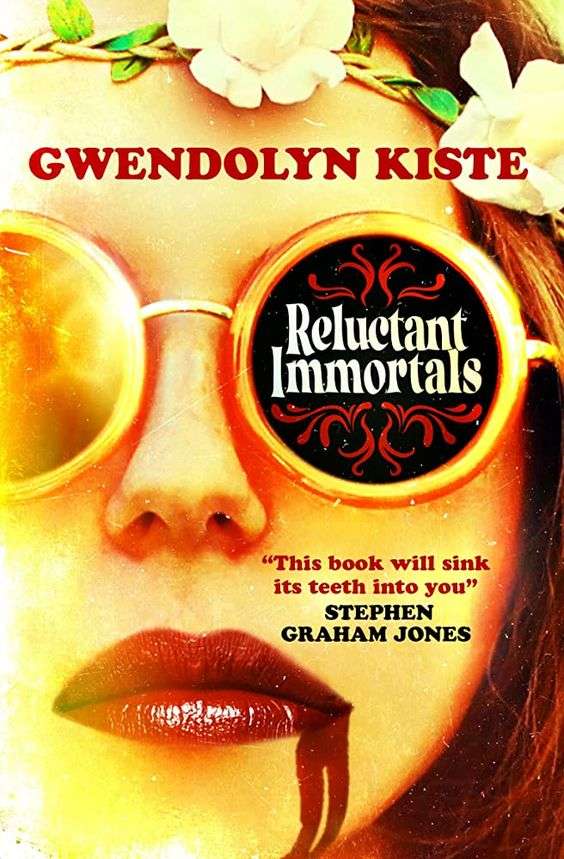Reluctant Immortals by Gwendolyn Kiste from @TitanBooks #BookReview #Horror #FeministRetelling
Reluctant Immortals by Gwendolyn Kiste
Titan, £8.99
Reviewed by Nadya Mercik

For me, Gwendolyn Kiste’s “Reluctant Immortals” was an ultimately feministic retelling, bringing together “Dracula” by Bram Stocker and “Jane Eyre” by Charlotte Bronte. Though personally not a huge fan of America 70s, I should say that LA and San Francisco of that time felt like a perfect background for the unfolding events – murky, full of hippies, so unlike Victorian England and the Romanian castles, and at the same time just right for the celebrity immortals and their reluctant victims.
The story begins when we see Lucy Westenra burying one of the urns with Dracula’s remains under the Hollywood sign since it has been annoying her greatly in recent days. She is joined by her friend – Bee. Short for Bertha Mason, the first wife of Edward Rochester. They had met each other back in London seventy years ago, immortality and their terrible partners of the past bringing them together, and soon decided to move to the States to start a new life. They live in a decaying house they bartered for some jewellery and have just $100 left to spend. Every night they go to an open-air movie theatre and afterwards check on Dracula’s urns: the remains in them are constantly trying to escape and return to life. Unlike Lucy, Bee is not a vampire, but the way how she became immortal remains a secret for the first few chapters. All we know is that it was not her choice but another unasked present from Rochester.
Their life is not much; unlike so many other immortal characters in literature and films, they are not enjoying a rich and lavish existence. Bee is suffering from nightmares; the thing that keeps her alive after death stirs every night, and Rochester just cannot shut up and keeps calling Bee. Dracula is Lucy’s curse, constantly whispering to her in the ear that she needs to go and feed on blood – something Lucy is stalwartly abstaining from. Nonetheless, they are trying to enjoy what they have until one day, a person from the past pays them a visit – non-other than Jane Eyre herself. She begs for shelter, claiming she has had enough of Rochester and has left him for good. Bee, who turns out to have feelings for Jane, insists that she stays, and on the first evening, Jane breaks one of Dracula’s urns as she helps clean the house. From there, everything plummets down the hill, as even those small things Lucy and Bee possessed are taken from them.
To reclaim their lives and finally drive their men away, Lucy and Bee go to San Francisco and confront their torturers. In the very end, there is an almost epic battle to end the oppression and the rule of Dracula and Rochester and become the immortals they would like to be.
The story is permeated with the theme of choice and being the owner of your own life. It is not only about Lucy and Bee and how they have been treated. When they finally reach Rochester, they find out that he has been hypnotising girls for years, making them flock to him. Lucy is trying to save not only herself but all the other girls whom Dracula will devour. Gwendolyn Kiste draws her female immortals as vulnerable creatures who suffered in the arms of men, who were blamed for the lies men tell, and who are still reliving the same nightmares. Lucy constantly keeps reminding us that their opponents have so many ways to destroy them while they have a very limited arsenal, and there are just the two of them against Rochester and Dracula’s powers. There are references to the original films and books and how these men transpired as heroes.
The novel is filled with the pull of opposites. Lucy hates Dracula, yet she is drawn to him – she desires him, and in some ways, she craves his touch and closeness. She is like him, and she is utterly not like him. When you read it, it is like a passionate Argentinian tango, which is then suddenly stripped of all its eroticism and desire when we realise what stands behind it.
Though the novel tries to bring Lucy and Bee on the same level, it still feels more like the story of Lucy, for she fights against Dracula and, at some point, against Rochester too. Besides, she is the first person telling us the story. It feels like, for a chunk of the narration, Bee remains the secondary character until in the end they both get their fair share of representation.
The story flows smoothly, the stakes constantly rising, but personally, I was struggling a bit with some minor details of the story – like when Lucy spends her last fiver at the gas station and then considers going to the movies, which also cost a fiver, how later on they find extra money in the glove compartment and how in general they managed to survive with $100 all these years going to the movies every day and buying tickets and popcorn. This was just something chafing me as I was reading.
In general, I would say that “Reluctant Immortals” is a nice gothic retelling with a strong feminist angle and fast pace, which attempts to reinvent the personalities of Dracula and Rochester. If you are keen to break the old stereotypes, see them as villains and read how women shed the chains of victims, it will be your story.
